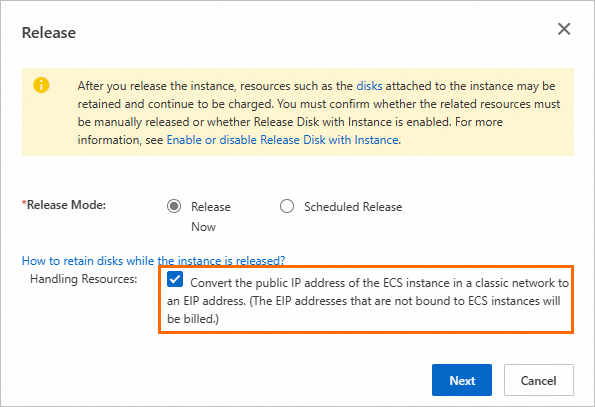If you want to retain the static public IP address (also called system-assigned public IP address) of an Elastic Compute Service (ECS) instance in the classic network when you release the instance, you can convert the static public IP address into an elastic IP address (EIP). This conversion is suitable for various scenarios, such as when you want to reuse the static public IP address of the instance, perform network migration, or flexibly modify configurations.
For information about how to convert the static public IP address of an ECS instance in a virtual private cloud (VPC) into an EIP, see Convert the public IP address of an ECS instance in a VPC to an EIP.
Prerequisites
Make sure that the ECS instance meets the following requirements:
The instance resides in the classic network and a public IP address is assigned by the system to the instance.
If the instance is a pay-as-you-go instance, it is in the Stopped state and you do not have overdue payments in your account.
If the instance is a subscription instance, it is in the Expired
state.NoteAfter you convert the static public IP address of a subscription instance that resides in the classic network into an EIP, you can immediately release the instance if the instance is in the Expired
state. If the subscription instance in the classic network has not expired, change the instance billing method to pay-as-you-go before you release the instance. For information about how to change the instance billing method, see Change the billing method of an instance from subscription to pay-as-you-go.If the instance is a subscription instance, the instance has at least 24 hours remaining in its subscription duration and uses the pay-by-traffic billing method for network usage. If the subscription instance uses the pay-by-bandwidth billing method for network usage, change the billing method for network usage to pay-by-traffic. For more information, see Overview of instance configuration changes.
If the instance type is being changed, wait until the change takes effect before you convert the static public IP address.
Snapshots are created to back up data, which prevents data loss induced by accidental operations. For more information, see Create a snapshot for a disk.
Precautions
Before you convert the static public IP address of an ECS instance that resides in the classic network into an EIP and release the instance, take note of the following items:
The metering method of the EIP is pay-by-traffic.
The public bandwidth of the EIP is the same as that of the ECS instance. You can increase the public bandwidth of the EIP in the VPC console. However, if the public bandwidth of the ECS instance is 0 Mbit/s, the public bandwidth of the EIP is 1 Mbit/s.
After the ECS instance is released, the EIP can no longer be associated with an ECS instance that resides in the classic network.
Unlike ECS instances in VPCs, ECS instances in the classic network can be equipped with public network interface controllers (NICs). After the static public IP address of an ECS instance in the classic network is converted into an EIP, the NICs connected to the public network are unbound from the instance and their media access control (MAC) addresses are released.
Procedure
Log on to the ECS console.
In the left-side navigation pane, choose .
In the top navigation bar, select the region and resource group to which the resource belongs.

Find an ECS instance that resides in the classic network and perform one of the following operations based on the instance billing method to release the instance:
To release a subscription instance, click Release in the Billing Method column.
To release a pay-as-you-go instance, choose in the Actions column.
In the Release dialog box, set Release Settings to Release Now, select
Convert the public IP address of the ECS instance in a classic network to an EIP address. (The EIP addresses that are not bound to ECS instances will be billed.), and then click Next.
Click OK.
After the static public IP address is converted into an EIP, the ECS instance is released. You can view the new EIP in the VPC console.

Related operations
Associate the EIP with a Server Load Balancer (SLB) instance or an ECS instance in a VPC. For information about how to associate an EIP with an instance, see Associate or disassociate an EIP.
Use
Internet Shared Bandwidth to reduce your costs in data transfer over the Internet. For more information, see Reduce the costs of data transfer over the Internet.Release the EIP. You are charged for the EIP until it is released. If you no longer use the EIP, release the EIP. For more information, see Release a pay-as-you-go EIP.
 > Instance Status > Release
> Instance Status > Release